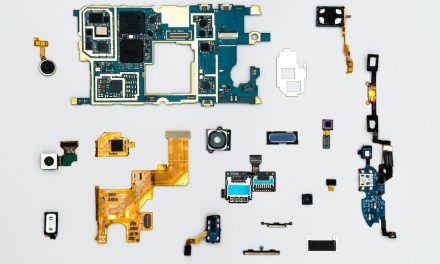Table of Contents
- Introduction
- Leveraging Data Analytics for Performance Insights
- Implementing Real-Time Feedback Tools
- Automating Performance Reviews with Software
- Using AI for Predictive Performance Analysis
- Integrating Performance Management Systems with HRIS
- Gamification in Performance Improvement
- Mobile Apps for Performance Tracking
- Virtual Reality Training for Skill Development
- Q&A
- Conclusion
“Empower your team, elevate your results with cutting-edge performance management technology.”
Introduction
Introduction:
Maximizing Performance Management with Technology is essential for organizations looking to improve employee productivity, engagement, and overall business success. By leveraging technology tools and platforms, companies can streamline performance evaluation processes, provide real-time feedback, and track progress towards goals more effectively. In this article, we will explore the benefits of using technology in performance management and discuss how organizations can leverage these tools to drive better results.
Leveraging Data Analytics for Performance Insights
Performance management is a critical aspect of any organization’s success. It involves setting clear goals, providing feedback, and evaluating employee performance to ensure that individuals are meeting expectations and contributing to the overall success of the organization. Traditionally, performance management has been a manual and time-consuming process, often relying on subjective evaluations and paper-based systems. However, with the advancement of technology, organizations now have the opportunity to leverage data analytics to gain valuable insights into employee performance and make more informed decisions.
Data analytics involves the use of statistical analysis and algorithms to extract meaningful information from large sets of data. By collecting and analyzing data on employee performance, organizations can identify trends, patterns, and correlations that can help them better understand how their employees are performing and what factors may be influencing their performance. This information can then be used to make more informed decisions about training, development, and performance improvement strategies.
One of the key benefits of leveraging data analytics for performance management is the ability to track and measure performance in real-time. Traditional performance management systems often rely on annual or semi-annual reviews, which can be time-consuming and may not provide a comprehensive picture of an employee’s performance. By using data analytics, organizations can track performance metrics on an ongoing basis, allowing them to identify issues and address them in a timely manner.
Another benefit of using data analytics for performance management is the ability to identify high-performing employees and reward them accordingly. By analyzing performance data, organizations can identify top performers and provide them with opportunities for advancement, recognition, and rewards. This can help to motivate employees and encourage them to continue performing at a high level.
In addition to identifying high-performing employees, data analytics can also help organizations identify underperforming employees and provide them with the support and resources they need to improve. By analyzing performance data, organizations can identify areas where employees may be struggling and develop targeted training and development programs to help them improve their performance. This can help to increase employee engagement and productivity, ultimately leading to better overall performance for the organization.
Furthermore, data analytics can also help organizations identify trends and patterns in employee performance that may be impacting overall organizational performance. By analyzing performance data across the organization, organizations can identify common themes or issues that may be hindering performance and develop strategies to address them. This can help to improve overall organizational performance and drive better results.
Overall, leveraging data analytics for performance management can help organizations make more informed decisions about their employees and improve overall organizational performance. By tracking performance metrics in real-time, identifying high-performing and underperforming employees, and identifying trends and patterns in performance data, organizations can gain valuable insights into employee performance and make more strategic decisions about training, development, and performance improvement strategies. In today’s competitive business environment, organizations that leverage data analytics for performance management will have a significant advantage in driving better results and achieving their goals.
Implementing Real-Time Feedback Tools
Performance management is a critical aspect of any organization’s success. It involves setting clear goals, providing feedback, and evaluating employee performance to ensure that individuals are meeting expectations and contributing to the overall success of the company. Traditionally, performance management has been a manual and time-consuming process, often relying on annual or semi-annual reviews to provide feedback to employees. However, with the advancement of technology, organizations now have the opportunity to implement real-time feedback tools to maximize the effectiveness of their performance management processes.
Real-time feedback tools allow managers and employees to provide and receive feedback on an ongoing basis, rather than waiting for scheduled performance reviews. This immediate feedback can help employees understand how their actions are impacting their performance and make adjustments as needed. Additionally, real-time feedback tools can help managers identify and address performance issues in a timely manner, rather than waiting until the end of the year to provide feedback.
One of the key benefits of real-time feedback tools is the ability to track performance trends over time. By collecting and analyzing data on employee performance, organizations can identify patterns and trends that may indicate areas for improvement. For example, if a particular team consistently receives low scores on a certain metric, managers can use this information to provide targeted training or coaching to help improve performance. This data-driven approach to performance management can help organizations make more informed decisions about how to support their employees and drive overall performance.
Another benefit of real-time feedback tools is the ability to promote a culture of continuous improvement. By providing employees with regular feedback on their performance, organizations can encourage a growth mindset and a focus on learning and development. Employees who receive regular feedback are more likely to take ownership of their performance and seek out opportunities for growth and development. This can lead to increased employee engagement, motivation, and ultimately, improved performance.
Implementing real-time feedback tools in an organization requires careful planning and consideration. It is important to select a tool that aligns with the organization’s goals and values, as well as the needs of its employees. Additionally, organizations must ensure that managers and employees are trained on how to use the tool effectively and that there are clear guidelines in place for providing and receiving feedback.
When implementing real-time feedback tools, organizations should also consider the importance of data privacy and security. It is essential to ensure that employee data is protected and that all feedback is provided in a respectful and constructive manner. By prioritizing data privacy and security, organizations can build trust with their employees and create a positive feedback culture.
In conclusion, real-time feedback tools can be a valuable asset for organizations looking to maximize the effectiveness of their performance management processes. By providing employees with regular feedback, tracking performance trends over time, and promoting a culture of continuous improvement, organizations can drive employee engagement, motivation, and ultimately, performance. With careful planning and consideration, organizations can successfully implement real-time feedback tools to support their employees and achieve their performance management goals.
Automating Performance Reviews with Software

Performance management is a critical aspect of any organization’s success. It involves setting goals, providing feedback, and evaluating employee performance to ensure that individuals are meeting expectations and contributing to the overall success of the company. Traditionally, performance reviews have been conducted manually, with managers and employees meeting face-to-face to discuss performance and set goals for the future. However, with advancements in technology, many organizations are now turning to software to automate the performance review process.
Automating performance reviews with software offers a number of benefits for both employees and managers. One of the key advantages is the ability to streamline the review process, making it more efficient and less time-consuming for all parties involved. With software, managers can easily set goals, track progress, and provide feedback throughout the year, rather than waiting for an annual review. This continuous feedback loop can help employees stay on track and make improvements in real-time, rather than waiting for feedback months down the line.
Another benefit of using software for performance reviews is the ability to track and analyze data more effectively. With manual reviews, it can be difficult to keep track of all the feedback and performance data for each employee. However, with software, all of this information is stored in one centralized location, making it easy to access and analyze. This data can be used to identify trends, track progress over time, and make more informed decisions about employee development and performance management.
In addition to streamlining the review process and tracking data more effectively, software can also help to improve the overall quality of performance reviews. Many software programs come equipped with built-in templates and guidelines to help managers structure their feedback and set goals that are specific, measurable, achievable, relevant, and time-bound (SMART). This can help to ensure that reviews are fair, consistent, and focused on the most important aspects of performance.
Furthermore, software can also help to facilitate communication between managers and employees. Many programs offer features such as messaging and chat functions, making it easy for employees to ask questions, seek clarification, and provide updates on their progress. This can help to foster a more open and transparent dialogue between managers and employees, leading to more effective performance management overall.
Overall, automating performance reviews with software can help organizations maximize the effectiveness of their performance management processes. By streamlining the review process, tracking data more effectively, improving the quality of reviews, and facilitating communication between managers and employees, software can help to ensure that employees are meeting expectations and contributing to the success of the organization. As technology continues to advance, more and more organizations are likely to turn to software to enhance their performance management practices and drive better results.
Using AI for Predictive Performance Analysis
Performance management is a critical aspect of any organization’s success, as it involves setting goals, monitoring progress, providing feedback, and evaluating performance. Traditionally, performance management has been a manual and time-consuming process, often relying on subjective assessments and outdated methods. However, with the advancements in technology, particularly artificial intelligence (AI), organizations can now leverage predictive performance analysis to maximize their performance management efforts.
AI has revolutionized the way organizations approach performance management by providing data-driven insights and predictive analytics. By analyzing vast amounts of data, AI can identify patterns, trends, and correlations that may not be apparent to human observers. This allows organizations to make more informed decisions about their employees’ performance and potential areas for improvement.
One of the key benefits of using AI for predictive performance analysis is its ability to forecast future performance based on historical data. By analyzing past performance metrics, AI algorithms can predict how an employee is likely to perform in the future. This can help organizations identify high-performing employees, as well as those who may need additional support or training to improve their performance.
In addition to predicting future performance, AI can also help organizations identify factors that may impact employee performance. By analyzing various data points, such as employee engagement, job satisfaction, and work-life balance, AI can pinpoint potential issues that may be affecting performance. This allows organizations to address these issues proactively and create a more conducive work environment for their employees.
Furthermore, AI can also help organizations optimize their performance management processes by automating repetitive tasks and streamlining workflows. For example, AI-powered performance management systems can automatically collect and analyze performance data, generate performance reports, and provide real-time feedback to employees. This not only saves time and resources but also ensures that performance management processes are more efficient and effective.
Another advantage of using AI for predictive performance analysis is its ability to personalize performance management strategies for individual employees. By analyzing each employee’s unique performance data and preferences, AI can tailor performance management interventions to meet their specific needs and goals. This personalized approach can help employees feel more engaged and motivated, leading to improved performance outcomes.
Overall, leveraging AI for predictive performance analysis can help organizations maximize their performance management efforts by providing data-driven insights, forecasting future performance, identifying performance factors, optimizing processes, and personalizing strategies. By harnessing the power of AI, organizations can make more informed decisions about their employees’ performance, drive continuous improvement, and ultimately achieve their business goals.
In conclusion, technology, particularly AI, has the potential to revolutionize performance management by providing organizations with the tools and insights they need to optimize their performance management efforts. By leveraging predictive performance analysis, organizations can make more informed decisions, identify areas for improvement, and personalize strategies to enhance employee performance. As technology continues to advance, organizations that embrace AI for performance management will have a competitive advantage in today’s fast-paced business environment.
Integrating Performance Management Systems with HRIS
Performance management is a critical aspect of any organization’s success. It involves setting clear goals, providing feedback, and evaluating employee performance to ensure that individuals are meeting expectations and contributing to the overall success of the organization. In today’s fast-paced business environment, it is essential for companies to leverage technology to streamline and enhance their performance management processes.
One way that organizations can maximize their performance management efforts is by integrating performance management systems with their Human Resources Information Systems (HRIS). HRIS is a software solution that helps organizations manage their human resources functions, such as payroll, benefits administration, and employee records. By integrating performance management systems with HRIS, organizations can create a more seamless and efficient process for managing employee performance.
One of the key benefits of integrating performance management systems with HRIS is the ability to centralize all employee data in one system. This allows managers and HR professionals to easily access and review employee performance data, such as goals, feedback, and evaluations, all in one place. This centralized approach can help to streamline the performance management process, making it easier for managers to track employee progress and provide timely feedback.
Another benefit of integrating performance management systems with HRIS is the ability to automate certain aspects of the performance management process. For example, organizations can set up automated reminders for managers to provide feedback to employees, or automate the process of setting and tracking employee goals. By automating these tasks, organizations can save time and ensure that the performance management process is consistent and efficient across the organization.
Integrating performance management systems with HRIS can also help organizations to better analyze and report on employee performance data. By centralizing all employee data in one system, organizations can more easily track trends and patterns in employee performance, identify areas for improvement, and make data-driven decisions about employee development and training. This can help organizations to better align their performance management efforts with their overall business goals and objectives.
In addition to streamlining and enhancing the performance management process, integrating performance management systems with HRIS can also help organizations to improve employee engagement and satisfaction. By providing employees with easy access to their performance data, goals, and feedback, organizations can empower employees to take ownership of their own development and performance. This can lead to increased motivation, productivity, and job satisfaction among employees.
Overall, integrating performance management systems with HRIS can help organizations to maximize their performance management efforts and achieve better results. By centralizing employee data, automating tasks, and analyzing performance data, organizations can create a more efficient and effective performance management process that aligns with their business goals and objectives. This can lead to improved employee performance, engagement, and satisfaction, ultimately driving greater success for the organization as a whole.
Gamification in Performance Improvement
Performance management is a critical aspect of any organization’s success. It involves setting goals, providing feedback, and evaluating employee performance to ensure that individuals are meeting expectations and contributing to the overall success of the company. Traditionally, performance management has been a manual and time-consuming process, often relying on subjective evaluations and paper-based systems. However, with the advancement of technology, organizations now have the opportunity to streamline and enhance their performance management processes through the use of gamification.
Gamification is the application of game design elements and principles in non-game contexts to engage and motivate individuals to achieve their goals. In the context of performance management, gamification can be used to make the process more interactive, engaging, and rewarding for employees. By incorporating elements such as points, badges, leaderboards, and rewards into the performance management process, organizations can create a more dynamic and motivating environment for employees to excel.
One of the key benefits of using gamification in performance management is that it can help to increase employee engagement and motivation. By turning performance management into a game-like experience, employees are more likely to be actively involved in setting and achieving their goals. This can lead to higher levels of productivity, job satisfaction, and overall performance. In addition, gamification can also help to make the performance management process more transparent and objective, as employees can track their progress and see how they compare to their peers in real-time.
Another advantage of using gamification in performance management is that it can help to foster a culture of continuous improvement within the organization. By providing employees with regular feedback and opportunities to earn rewards for their achievements, organizations can encourage individuals to strive for excellence and constantly seek ways to improve their performance. This can lead to a more dynamic and innovative workforce that is constantly pushing the boundaries of what is possible.
Furthermore, gamification can also help to make the performance management process more efficient and effective. By automating certain aspects of the process, such as goal-setting, feedback, and evaluation, organizations can save time and resources that can be better spent on other strategic initiatives. In addition, by using technology to track and analyze performance data, organizations can gain valuable insights into employee performance trends and areas for improvement, allowing them to make more informed decisions about talent development and succession planning.
Overall, gamification has the potential to revolutionize the way organizations approach performance management. By leveraging technology and game design principles, organizations can create a more engaging, motivating, and effective performance management process that drives employee performance and organizational success. As technology continues to advance, the possibilities for using gamification in performance management are endless, and organizations that embrace this approach are likely to see significant benefits in terms of employee engagement, productivity, and overall performance.
Mobile Apps for Performance Tracking
Performance management is a critical aspect of any organization’s success. It involves setting clear goals, providing feedback, and evaluating employee performance to ensure that individuals are meeting expectations and contributing to the overall success of the company. In today’s fast-paced business environment, technology plays a crucial role in streamlining and enhancing performance management processes. One area where technology has made a significant impact is in the development of mobile apps for performance tracking.
Mobile apps have revolutionized the way organizations track and manage employee performance. These apps provide a convenient and efficient way for managers to monitor employee progress, provide feedback, and make data-driven decisions. With the increasing popularity of remote work and flexible work arrangements, mobile apps have become essential tools for keeping employees engaged and motivated, regardless of their physical location.
One of the key benefits of using mobile apps for performance tracking is the ability to provide real-time feedback. Traditional performance management processes often involve annual or semi-annual reviews, which can be time-consuming and ineffective in today’s fast-paced business environment. Mobile apps allow managers to provide feedback on an ongoing basis, enabling employees to make immediate adjustments and improvements to their performance.
In addition to real-time feedback, mobile apps also provide valuable data and insights into employee performance. These apps can track key performance indicators, such as sales numbers, project completion rates, and customer satisfaction scores, allowing managers to identify trends and patterns in employee performance. By analyzing this data, managers can make informed decisions about training, development, and performance improvement initiatives.
Furthermore, mobile apps for performance tracking can help streamline the performance review process. These apps often include built-in templates and tools for conducting performance evaluations, making it easier for managers to assess employee performance and provide constructive feedback. By automating the performance review process, organizations can save time and resources while ensuring that evaluations are fair, consistent, and objective.
Another advantage of using mobile apps for performance tracking is the ability to set and track goals. These apps allow managers to establish clear, measurable goals for employees and track progress towards achieving those goals. By setting goals and tracking progress, employees are more likely to stay motivated and focused on achieving their objectives. Additionally, managers can use the data collected from these apps to identify high-performing employees and provide them with opportunities for advancement and recognition.
Overall, mobile apps for performance tracking offer numerous benefits for organizations looking to maximize their performance management processes. By providing real-time feedback, valuable data and insights, streamlined performance reviews, and goal setting capabilities, these apps can help organizations improve employee engagement, productivity, and overall performance. As technology continues to evolve, mobile apps for performance tracking will likely become even more sophisticated and essential tools for organizations seeking to drive success through effective performance management.
Virtual Reality Training for Skill Development
Performance management is a critical aspect of any organization’s success. It involves setting goals, providing feedback, and evaluating employee performance to ensure that individuals are meeting expectations and contributing to the overall success of the organization. Traditionally, performance management has been a manual process, with managers and employees meeting regularly to discuss goals and progress. However, with advancements in technology, organizations are now able to leverage tools such as virtual reality training to enhance their performance management processes.
Virtual reality training is a cutting-edge technology that allows individuals to immerse themselves in a simulated environment where they can practice and develop their skills. This technology has been widely used in industries such as healthcare, aviation, and manufacturing to train employees in complex and high-risk scenarios. However, virtual reality training can also be a valuable tool for performance management, allowing organizations to provide employees with hands-on training and feedback in a safe and controlled environment.
One of the key benefits of virtual reality training for performance management is its ability to provide employees with realistic and immersive learning experiences. Traditional training methods, such as classroom lectures or online courses, can be effective in teaching theoretical concepts, but they often fall short when it comes to practical skills development. Virtual reality training, on the other hand, allows employees to practice their skills in a realistic and interactive environment, making it easier for them to transfer their learning to real-world situations.
In addition to providing realistic training experiences, virtual reality training can also help organizations track and measure employee performance more effectively. By using sensors and tracking devices, organizations can collect data on how employees are performing in the virtual environment, allowing them to identify areas where individuals may need additional support or training. This data can then be used to provide targeted feedback and coaching to help employees improve their performance.
Furthermore, virtual reality training can also help organizations streamline their performance management processes. By providing employees with on-demand access to training modules and simulations, organizations can ensure that individuals are continuously developing their skills and staying up-to-date with industry best practices. This can help organizations identify high-performing employees and provide them with opportunities for advancement, while also addressing any performance gaps that may exist within the workforce.
Overall, virtual reality training has the potential to revolutionize performance management by providing employees with realistic training experiences, helping organizations track and measure employee performance more effectively, and streamlining performance management processes. By leveraging this cutting-edge technology, organizations can maximize the potential of their workforce and drive greater success in today’s competitive business environment.
Q&A
1. How can technology help in maximizing performance management?
Technology can help in automating performance evaluations, tracking employee progress, providing real-time feedback, and analyzing performance data.
2. What are some examples of performance management technology?
Examples include performance management software, goal-setting tools, feedback platforms, and data analytics tools.
3. How can technology improve employee engagement in performance management?
Technology can provide employees with more frequent feedback, personalized development plans, and opportunities for self-assessment.
4. What are the benefits of using technology for performance management?
Benefits include increased efficiency, more accurate performance evaluations, better alignment of individual goals with organizational objectives, and improved employee engagement.
5. How can technology help in identifying and addressing performance gaps?
Technology can help in tracking performance metrics, identifying areas of improvement, and providing targeted training and development opportunities.
6. How can technology support continuous performance management?
Technology can enable ongoing feedback and coaching, regular check-ins between managers and employees, and real-time performance tracking.
7. How can technology help in setting and tracking performance goals?
Technology can facilitate the setting of SMART goals, provide progress updates, and track goal achievement over time.
8. How can organizations ensure successful implementation of performance management technology?
Organizations can ensure successful implementation by providing training and support to employees, aligning technology with organizational goals, and regularly evaluating the effectiveness of the technology.
Conclusion
Conclusion: Maximizing performance management with technology can greatly improve efficiency, accuracy, and overall effectiveness in evaluating and developing employees. By utilizing tools such as data analytics, automated performance reviews, and real-time feedback systems, organizations can better track progress, identify areas for improvement, and ultimately drive better results. Embracing technology in performance management can lead to a more engaged and motivated workforce, ultimately contributing to the success of the organization.





